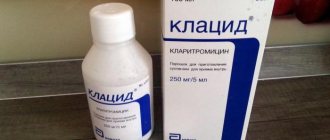Indications for use
Infectious and inflammatory diseases caused by microorganisms sensitive to clarithromycin:
- infections of the lower respiratory tract (including bronchitis, pneumonia);
- upper respiratory tract infections (including pharyngitis, sinusitis);
- infections of the skin and soft tissues (including folliculitis, inflammation of the subcutaneous tissue, erysipelas);
- disseminated or localized mycobacterial infections caused by Mycobacterium avium and Mycobacterium intracellulare;
- localized infections caused by Mycobacterium chelonae, Mycobacterium fortuitum and Mycobacterium kansasii;
- acute otitis media.
Directions for use and doses
The prepared suspension should be taken orally regardless of food intake (with milk).
To prepare the suspension, water is gradually added to the bottle up to the mark, then the bottle is shaken. The prepared suspension can be stored for 14 days at room temperature (15° to 30°C). Before each dose, the suspension should be shaken well.
- The recommended daily dose of clarithromycin suspension for mycobacterial infections is 7.5 mg/kg 2 times a day. The maximum dose is 500 mg 2 times/day. The usual duration of treatment is 5-10 days, depending on the pathogen and the severity of the patient's condition.
- In children with disseminated or local mycobacterial infections (M. avium, M. intracellulare, M. chelonae, M. fortuitum, M. kansasii), the recommended dose of clarithromycin is 7.5-15 mg/kg 2 times/day.
Treatment with clarithromycin should be continued as long as the clinical effect persists. Clarithromycin should be prescribed in combination with other antimicrobial drugs active against these pathogens.
Klacid
Clarithromycin inhibits the activity of the CYP3A4 isoenzyme, which leads to a slower rate of metabolism of astemizole when used simultaneously. As a result, there is an increase in the QT interval and an increased risk of developing ventricular arrhythmias.
Concomitant use of clarithromycin with lovastatin or simvastatin is contraindicated due to the fact that these statins are largely metabolized by the CYP3A4 isoenzyme, and co-administration with clarithromycin increases their serum concentrations, which leads to an increased risk of developing myopathy, including rhabdomyolysis. Cases of rhabdomyolysis have been reported in patients taking clarithromycin concomitantly with these drugs. If clarithromycin is necessary, lovastatin or simvastatin should be discontinued during therapy.
Clarithromycin should be used with caution in combination therapy with other statins. It is recommended to use statins that do not depend on the metabolism of CYP3A isoenzymes (for example, fluvastatin). If coadministration is necessary, it is recommended to take the lowest dose of statin. The development of signs and symptoms of myopathy should be monitored. When used simultaneously with atorvastatin, the concentration of atorvastatin in the blood plasma increases moderately and the risk of developing myopathy increases.
Drugs that are CYP3A inducers (for example, rifampicin, phenytoin, carbamazepine, phenobarbital, St. John's wort) can induce the metabolism of clarithromycin, which can lead to subtherapeutic concentrations of clarithromycin and a decrease in its effectiveness. It is necessary to monitor the plasma concentration of the CYP3A inducer, which may increase due to the inhibition of CYP3A by clarithromycin.
When used together with rifabutin, the concentration of rifabutin in the blood plasma increases, the risk of developing uveitis increases, and the concentration of clarithromycin in the blood plasma decreases.
When used together with clarithromycin, plasma concentrations of phenytoin, carbamazepine, and valproic acid may increase.
Strong inducers of isoenzymes of the cytochrome P450 system, such as efavirenz, nevirapine, rifampicin, rifabutin and rifapentine, can accelerate the metabolism of clarithromycin and, thus, reduce the concentration of clarithromycin in plasma and weaken its therapeutic effect, and at the same time increase the concentration of 14-OH-clarithromycin - metabolite, which is also microbiologically active. Since the microbiological activity of clarithromycin and 14-OH-clarithromycin differs against different bacteria, the therapeutic effect may be reduced when clarithromycin is used together with enzyme inducers.
The plasma concentration of clarithromycin decreases with the use of etravirine, while the concentration of the active metabolite 14-OH-clarithromycin increases. Because 14-OH-clarithromycin has low activity against MAC infections, overall activity against MAC infections may be affected, and alternative treatments should be considered for the treatment of MAC.
A pharmacokinetic study showed that co-administration of ritonavir 200 mg every 8 hours and clarithromycin 500 mg every 12 hours resulted in a marked suppression of the metabolism of clarithromycin. When co-administered with ritonavir, clarithromycin Cmax increased by 31%, Cmin increased by 182% and AUC increased by 77%, while the concentration of its metabolite 14-OH-clarithromycin was significantly reduced. Ritonavir should not be co-administered with clarithromycin in doses exceeding 1 g/day.
Clarithromycin, atazanavir, and saquinavir are substrates and inhibitors of CYP3A, which determines their bidirectional interaction. When taking saquinavir with ritonavir, consider the potential effect of ritonavir on clarithromycin.
When used simultaneously with zidovudine, the bioavailability of zidovudine is slightly reduced.
Colchicine is a substrate of both CYP3A and P-glycoprotein. Clarithromycin and other macrolides are known to be inhibitors of CYP3A and P-glycoprotein. When clarithromycin and colchicine are taken together, inhibition of P-glycoprotein and/or CYP3A may result in increased effects of colchicine. The development of clinical symptoms of colchicine poisoning should be monitored. There have been post-marketing reports of cases of colchicine poisoning when taken concomitantly with clarithromycin, most often in elderly patients. Some of the reported cases occurred in patients with renal failure. Some cases were reported to be fatal. The simultaneous use of clarithromycin and colchicine is contraindicated.
When midazolam and clarithromycin were used together (500 mg orally 2 times a day), an increase in midazolam AUC was noted: 2.7 times after intravenous administration of midazolam and 7 times after oral administration. Concomitant use of clarithromycin with oral midazolam is contraindicated. If intravenous midazolam is used concomitantly with clarithromycin, the patient's condition should be carefully monitored for possible dose adjustment. The same precautions should be applied to other benzodiazepines that are metabolized by CYP3A, including triazolam and alprazolam. For benzodiazepines whose elimination is not dependent on CYP3A (temazepam, nitrazepam, lorazepam), a clinically significant interaction with clarithromycin is unlikely.
When clarithromycin and triazolam are used together, effects on the central nervous system, such as drowsiness and confusion, are possible. With this combination, it is recommended to monitor symptoms of central nervous system disorders.
When used simultaneously with warfarin, the anticoagulant effect of warfarin may be enhanced and the risk of bleeding may increase.
Digoxin is thought to be a substrate for P-glycoprotein. Clarithromycin is known to inhibit P-glycoprotein. When used simultaneously with digoxin, there may be a significant increase in the concentration of digoxin in the blood plasma and the risk of developing glycoside intoxication.
Ventricular tachycardia of the “pirouette” type may occur with the combined use of clarithromycin and quinidine or disopyramide. When clarithromycin is coadministered with these drugs, ECG monitoring should be performed regularly to monitor for QT interval prolongation, and serum concentrations of these drugs should also be monitored. During post-marketing use, cases of hypoglycemia have been reported during co-administration of clarithromycin and disopyramide. It is necessary to monitor the concentration of glucose in the blood while using clarithromycin and disopyramide. It is believed that it is possible to increase the concentration of disopyramide in the blood plasma due to inhibition of its metabolism in the liver under the influence of clarithromycin.
Co-administration of fluconazole at a dose of 200 mg daily and clarithromycin at a dose of 500 mg 2 times a day caused an increase in the mean minimum equilibrium concentration of clarithromycin (Cmin) and AUC by 33% and 18%, respectively. However, co-administration did not significantly affect the average steady-state concentration of the active metabolite 14-OH-clarithromycin. No dose adjustment of clarithromycin is required when taking fluconazole concomitantly.
Clarithromycin and itraconazole are substrates and inhibitors of CYP3A, which determines their bidirectional interaction. Clarithromycin may increase plasma concentrations of itraconazole, while itraconazole may increase plasma concentrations of clarithromycin.
When used simultaneously with methylprednisolone, the clearance of methylprednisolone decreases; with prednisone - cases of acute mania and psychosis have been described.
When used simultaneously with omeprazole, the concentration of omeprazole increases significantly and the concentration of clarithromycin in the blood plasma increases slightly; with lansoprazole - glossitis, stomatitis and/or the appearance of a dark color of the tongue are possible.
When used simultaneously with sertraline, the development of serotonin syndrome cannot be theoretically excluded; with theophylline - it is possible to increase the concentration of theophylline in the blood plasma.
When used simultaneously with terfenadine, it is possible to slow down the rate of metabolism of terfenadine and increase its concentration in the blood plasma, which can lead to an increase in the QT interval and an increased risk of developing ventricular arrhythmias.
Inhibition of the activity of the CYP3A4 isoenzyme under the influence of clarithromycin leads to a slower rate of metabolism of cisapride when used simultaneously. As a result, the concentration of cisapride in the blood plasma increases and the risk of developing life-threatening cardiac arrhythmias, including ventricular arrhythmias, increases.
The primary metabolism of tolterodine is carried out with the participation of CYP2D6. However, in the part of the population lacking CYP2D6, metabolism occurs with the participation of CYP3A. In this population, inhibition of CYP3A results in significantly higher serum concentrations of tolterodine. Therefore, in patients with low levels of CYP2D6-mediated metabolism, a reduction in the dose of tolterodine may be required in the presence of CYP3A inhibitors such as clarithromycin.
When clarithromycin is used together with oral hypoglycemic agents (for example, sulfonylureas) and/or insulin, severe hypoglycemia may occur. Concomitant use of clarithromycin with certain hypoglycemic drugs (for example, nateglinide, pioglitazone, repaglinide and rosiglitazone) may result in inhibition of CYP3A isoenzymes by clarithromycin, which may lead to hypoglycemia. It is believed that when used concomitantly with tolbutamide, there is a risk of developing hypoglycemia.
When used simultaneously with fluoxetine, a case of the development of toxic effects caused by the action of fluoxetine has been described.
When taking clarithromycin concomitantly with other ototoxic drugs, especially aminoglycosides, caution should be exercised and the functions of the vestibular and auditory systems should be monitored both during and after therapy.
When used simultaneously with cyclosporine, the concentration of cyclosporine in the blood plasma increases, and there is a risk of increased side effects.
When used simultaneously with ergotamine and dihydroergotamine, cases of increased side effects of ergotamine and dihydroergotamine have been described. Post-marketing studies show that when clarithromycin is used together with ergotamine or dihydroergotamine, the following effects associated with acute poisoning with drugs of the ergotamine group are possible: vascular spasm, ischemia of the limbs and other tissues, including the central nervous system. Concomitant use of clarithromycin and ergot alkaloids is contraindicated.
Each of these PDE inhibitors is metabolized, at least in part, by CYP3A. However, clarithromycin can inhibit CYP3A. Concomitant use of clarithromycin with sildenafil, tadalafil or vardenafil may lead to an increase in the inhibitory effect on PDE. With these combinations, consider reducing the dose of sildenafil, tadalafil and vardenafil.
When using clarithromycin simultaneously with calcium channel blockers that are metabolized by the CYP3A4 isoenzyme (for example, verapamil, amlodipine, diltiazem), caution should be exercised as there is a risk of arterial hypotension. Plasma concentrations of clarithromycin, as well as calcium channel blockers, may increase with simultaneous use. Arterial hypotension, bradyarrhythmia and lactic acidosis are possible when taking clarithromycin and verapamil simultaneously.
Contraindications
- simultaneous use with astemizole, cisapride, pimozide, terfenadine;
- simultaneous use with ergot alkaloids, for example, ergotamine, dihydroergotamine;
- simultaneous use with midazolam for oral administration;
- a history of QT prolongation, ventricular arrhythmia, or torsade de pointes (TdP);
- hypokalemia (risk of QT interval prolongation);
- severe liver failure occurring simultaneously with renal failure;
- simultaneous use of clarithromycin with HMG-CoA reductase inhibitors (statins), which are largely metabolized by the CYP3A4 isoenzyme (lovastatin, simvastatin), due to an increased risk of myopathy, including rhabdomyolysis;
- simultaneous use of clarithromycin with colchicine in patients with impaired liver or kidney function;
- history of cholestatic jaundice/hepatitis that developed while using clarithromycin;
- porphyria;
- congenital fructose intolerance, sucrase-isomaltase deficiency, glucose-galactose malabsorption syndrome;
- lactation period (breastfeeding);
- hypersensitivity to the components of the drug and other macrolides.
Instructions for use KLACID granules
Combinations are contraindicated due to the possible development of severe consequences of drug interactions
An increase in plasma concentrations of cisapride, pimozide and terfenadine in the blood serum was observed when they were used together with clarithromycin, which can lead to a prolongation of the QT interval and the occurrence of arrhythmias, incl. ventricular tachycardia, ventricular fibrillation and ventricular ari. Similar effects were observed with the combined use of astemizole and other macrolides.
Concomitant use of clarithromycin and ergotamine or dihydroergotamine has been associated with symptoms of acute ergotism, such as vasospasm and ischemia of the limbs and other tissues, including the central nervous system.
Effect of other drugs on the pharmacokinetics of clarithromycin
The effect of these drugs on clarithromycin blood concentrations is known or suspected, and dosage adjustments or alternative therapy may be necessary.
Potent inducers of the cytochrome P450 isoenzyme system, such as efavirenz, nevirapine, rifampicin, rifabutin and rifapentine, can accelerate the metabolism of clarithromycin, reducing its concentration in the blood plasma, but increasing the concentration of 14-OH-clarithromycin, a microbiologically active metabolite. Because The microbiological activity of clarithromycin and 14-OH-clarithromycin is different in relation to different bacteria; the expected therapeutic effect may not be achieved due to the combined use of clarithromycin and inducers of isoenzymes of the cytochrome P450 system.
Css of the active metabolite 14-OH-clarithromycin did not change significantly when combined with fluconazole. No clarithromycin dose change is required.
The use of ritonavir and clarithromycin led to a significant inhibition of clarithromycin metabolism. Cmax of clarithromycin increased by 31%. Cmin - by 182%, AUC increased by 77%. There was complete inhibition of the formation of 14-OH-clarithromycin. Due to the large therapeutic range, a dose reduction of clarithromycin is not required in patients with normal renal function. For patients with renal failure, dose adjustment is necessary:
- with CC 30-60 ml/min, the dose of clarithromycin should be reduced by 50%, with CC <30 ml/min - by 75%. Clarithromycin in doses exceeding 1 g/day should not be used together with ritonavir.
Effect of clarithromycin on the pharmacokinetics of other drugs
There are post-marketing reports of the development of ventricular tachycardia of the torsade de pointes type that occurred with the simultaneous use of clarithromycin with quinidine or disopyramide. It is recommended to carry out ECG monitoring for timely detection of QT interval prolongation. Serum concentrations of these drugs should be monitored during clarithromycin therapy.
Concomitant use of clarithromycin, a known inhibitor of the CYP3A isoenzyme, and a drug primarily metabolized by this isoenzyme, may cause an increase in the concentration of this drug in the blood plasma, which, in turn, may enhance or prolong its therapeutic effect and the risk of adverse reactions.
Caution should be exercised when using clarithromycin in patients receiving drugs that are CYP3A substrates, especially if they have a narrow therapeutic index (eg, carbamazepine) and/or are extensively metabolized by this isoenzyme.
In patients receiving clarithromycin, dose adjustments and, if possible, close monitoring of plasma concentrations of a drug metabolized by CYP3A may be necessary.
Such drugs or groups of drugs are metabolized by the same isoenzyme CYP3A:
- alprazolam, astemizole, carbamazepine, cilostazol, cisapride, cyclosporine, disopyramide, ergot alkaloids, lovastatin, methylprednisolone, midazolam, omeprazole, oral anticoagulants (eg, warfarin), pimozide, quinidine, rifabutin, sildenafil, simvastatin, tacrolimus, terfen adin, triazolam and vinblastine . A similar mechanism of interaction has been noted with the use of phenytoin. theophylline and valproate, metabolized by another isoenzyme of the cytochrome P450 system.
Like other macrolides, clarithromycin led to increased concentrations of HMG-CoA reductase inhibitors such as lovastatin and simvastatin. Rarely, rhabdomyolysis has been reported in patients when co-administered with these drugs.
The use of clarithromycin in combination with omeprazole in healthy adult volunteers resulted in an increase in the Css of omeprazole. When omeprazole was used alone, the average pH value of gastric juice when measured over 24 hours was 5.2, when omeprazole was used together with clarithromycin - 5.7.
The combined use of clarithromycin and oral anticoagulants may potentiate the effect of the latter, which requires careful monitoring of prothrombin time.
There is a possibility of increased plasma concentrations of PDE inhibitors (sildenafil, tadalfil and vardenafil) when used together with clarithromycin, which may require a reduction in the dose of PDE inhibitors.
The results of clinical studies have shown that there is a slight but statistically significant increase in plasma concentrations of theophylline or carbamazepine when used concomitantly with clarithromycin.
A dose reduction of tolterodine may be necessary when used with clarithromycin.
The combined use of oral midazolam and clarithromycin should be avoided. When administering midazolam intravenously with clarithromycin, the patient should be carefully monitored for timely dose adjustment. The same precautions should be taken when using other triazolebenzodiazepines that are metabolized by CYP3A, including triazolam and alprazolam. For benzodiazepines whose elimination does not depend on CYP3A (temazepam, nitrazepam, lorazepam), the development of a clinically significant interaction with clarithromycin is unlikely.
There are post-marketing reports of drug interactions and the development of adverse reactions from the central nervous system (such as drowsiness and confusion) with the combined use of clarithromycin and triazolam. The patient should be monitored for the possibility of increased pharmacological effects on the central nervous system.
Other types of interaction
Colchicine is a substrate of CYP3A and P-glycoprotein (Pgp). Clarithromycin and other macrolides are known to inhibit CYP3A and Pgp. When clarithromycin and colchicine are used concomitantly, inhibition of Pgp and/or CYP3A by clarithromycin may result in increased colchicine exposure. Patients should be monitored for clinical signs of colchicine toxicity.
During post-marketing surveillance, increased serum digoxin concentrations have been reported in patients receiving clarithromycin concomitantly with digoxin. Some patients developed signs of glycoside intoxication, incl. life-threatening arrhythmias. Serum digoxin concentrations in patients should be carefully monitored when administered with clarithromycin.
Concomitant use of clarithromycin immediate-release tablets and zidovudine in HIV-infected patients may cause a decrease in serum Css of zidovudine. This can be avoided by maintaining an interval between doses of clarithromycin and zidovudine. This interaction has not been reported with clarithromycin suspension and zidovudine or dideoxynosine in children.
Bidirectional drug interactions between clarithromycin and atazanavir, itraconazole, and saquinavir are also possible.
The development of arterial hypotension, bradyarrhythmia and lactic acidosis has been reported with the combined use of clarithromycin and verapamil.









